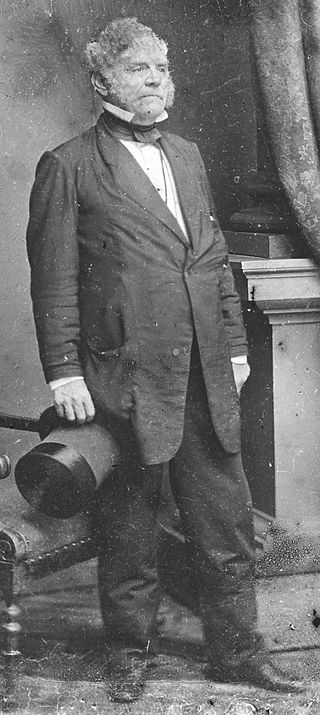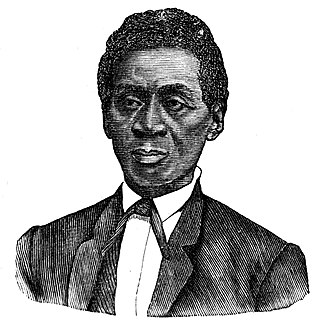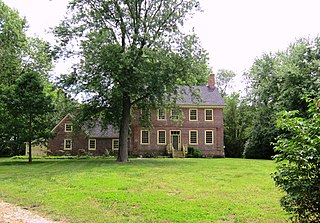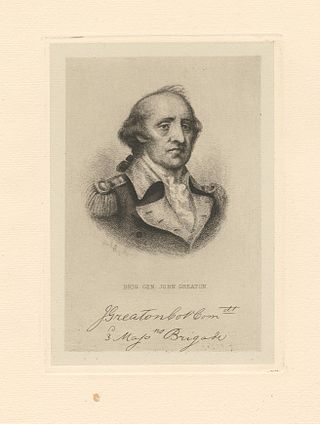
East New Market is a town located in Dorchester County, Maryland, United States. The population was 400 at the 2010 census. The ZIP code is 21631.

Redland is a census-designated place and an unincorporated area in Montgomery County, Maryland, United States. It had a population of 18,592 as of the 2020 census.
John Henry was the eighth Governor of Maryland and member of the United States Senate. He was born at his family's estate (Weston), located near Vienna in Dorchester County.

The Washington–Baltimore combined metropolitan statistical area is a statistical area, including the overlapping metropolitan areas of Washington, D.C. and Baltimore. The region includes Central Maryland, Northern Virginia, three counties in the Eastern Panhandle of West Virginia, and one county in south-central Pennsylvania. It is the most educated, highest-income, and third-most populous combined statistical area in the United States behind New York City–Newark, NJ and Los Angeles–Long Beach.

James McHenry was a Scotch-Irish American military surgeon, statesman, and a Founding Father of the United States. McHenry was a signer of the United States Constitution from Maryland, initiated the recommendation for Congress to form the Navy, and was the eponym of Fort McHenry. He represented Maryland in the Continental Congress. He was a delegate to the Maryland State Convention of 1788, to vote whether Maryland should ratify the proposed Constitution of the United States. He served as United States Secretary of War from 1796 to 1800, bridging the administrations of George Washington and John Adams. At the time of his death, McHenry owned 10 slaves, most of whom either worked as household servants or maintained his estate.
Thomas Sim Lee was an American planter, patriot and politician who served as Maryland Governor for five one-year terms, as well as in the Congress of the Confederation (1783–84), Maryland Ratification Convention of 1788 and House of Delegates in 1787. He also held local offices and owned many town lots in Georgetown (which became part of the new federal city, Washington, District of Columbia, and spent his final decades operating "Needwood" plantation in Frederick County, Maryland. In addition to working closely with many of the Founding fathers, he played an important part in the birth of his state and the nation.

Thomas Holliday Hicks was a politician in the divided border-state of Maryland during the American Civil War. As governor, opposing the Democrats, his views accurately reflected the conflicting local loyalties. He was pro-slavery but anti-secession. Under pressure to call the General Assembly into special session, he held it in the pro-Union town of Frederick, where he was able to keep the state from seceding to join the Confederacy.

Colonel Benjamin Tasker Jr. was a politician and slave trader in colonial Maryland, and Mayor of Annapolis from 1754 to 1755. He was the son of Benjamin Tasker Sr., Provincial Governor of Maryland from 1752 to 1753.

Samuel Green was a slave, freedman, and minister of religion. A conductor of the Underground Railroad, he was tried and convicted in 1857 of possessing a copy of the anti-slavery novel Uncle Tom's Cabin by Harriet Beecher Stowe following the Dover Eight incident. He received a ten-year sentence, and was pardoned by the Governor of Maryland Augustus Bradford in 1862, after he served five years.

Marucci Sports is an American sports equipment manufacturing company based in Baton Rouge, Louisiana. It focuses on baseball equipment, specifically producing bats, balls, gloves, batting gloves, batting helmets, and chest protectors. The company was originally founded in 2002 as the Marucci Bat Company by LSU Tigers head athletic trainer at that time, Jack Marucci The company was acquired by the investment firm Compass Diversified Holdings in 2020 and later by Fox Factory for $572 million in 2023.
Baltimore is a major media market, even though the city is only a 45-minute drive northeast of Washington, D.C.

Christ Episcopal Church and Cemetery is an historic Episcopal church and cemetery located at Cambridge, Dorchester County, Maryland, United States.

Friendship Hall is a historic home located at East New Market, Dorchester County, Maryland. It is a Georgian-style brick dwelling. It consists of a large five-bay, two-story main block built about 1790; a two-bay one-story passage; and a 1+1⁄2-story kitchen wing. Also on the property is a tall frame smokehouse with board-and-batten siding and a steep gable roof. It is associated with the locally prominent Sulivane family, who first came to Maryland in 1695.
The colonial families of Maryland were the leading families in the Province of Maryland. Several also had interests in the Colony of Virginia, and the two are sometimes referred to as the Chesapeake Colonies.

The Skirmish at Adamstown was a battle recorded by Frederick H. Dyer in Dyer's Compendiumfought between "Mean's and Atwell's West Virginia Cavalry Companies" and guerilla Confederate companies in Adamstown, Frederick County, Maryland, on October 14, 1864.
William Brinkley was a conductor on the Underground Railroad who helped more than 100 people achieve freedom by traveling from Camden, Delaware, past the "notoriously dangerous" towns of Dover and Smyrna north to Blackbird and sometimes as far as Wilmington, which was also very dangerous for runaway enslaved people. Some of his key rescues include the Tilly Escape of 1856, the Dover Eight in the spring of 1857, and the rescue of 28 people, more than half of which were children, from Dorchester County, Maryland. He had a number of pathways that he would take to various destinations, aided by his brother Nathaniel and Abraham Gibbs, other conductors on the railroad.

John Greaton, Jr. was an American inn-keeper and military leader from Roxbury, Massachusetts who served as a brigadier general in the Continental Army during the American Revolutionary War.











